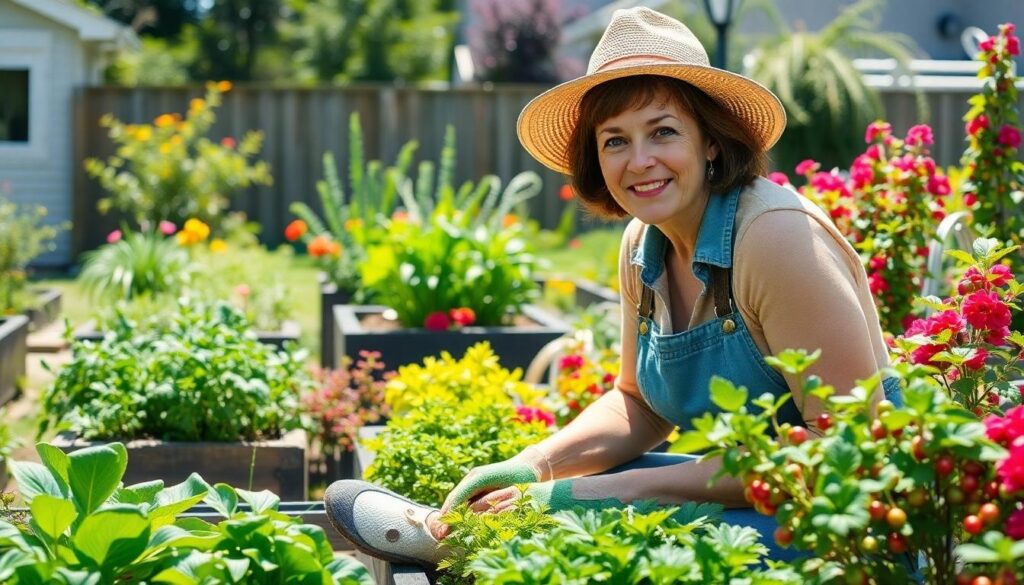Growing your own superfoods at home isn’t just a healthy hobby—it’s a revolution in your backyard! We’ve spent years perfecting the art of cultivating nutrient-dense powerhouses that can transform your health and slash your grocery bills.
In this ultimate guide, we’ll walk you through everything you need to know about growing superfoods in any space, whether you’ve got acres of land or just a sunny windowsill. From antioxidant-rich berries to leafy greens packed with vitamins, we’ll show you how to select, plant, nurture, and harvest these incredible edibles without complicated equipment or specialized knowledge.
What Are Backyard Superfoods and Why Should You Grow Them?
Backyard superfoods are nutrient-dense plants that can be grown in your home garden, patio containers, or even windowsills. These powerhouse plants pack exceptional nutritional value compared to regular produce, offering concentrated amounts of vitamins, minerals, antioxidants, and other beneficial compounds that support optimal health.
The Health Benefits of Home-Grown Superfoods
Growing your own superfoods delivers unmatched nutritional benefits that store-bought alternatives simply can’t compete with. Freshly harvested produce contains significantly higher levels of nutrients, as vegetables begin losing vital compounds immediately after being picked. Homegrown kale, for example, offers up to 30% more vitamin C when consumed within hours of harvesting compared to store-bought versions that traveled days to reach your plate.
Access to these nutrient-dense foods encourages healthier eating habits naturally, with many gardeners reporting they consume more vegetables when growing them at home. Superfoods like blueberries provide powerful antioxidants that fight inflammation and protect against chronic diseases, while leafy greens such as spinach deliver essential minerals that support immune function.
Many backyard superfoods also contain beneficial phytochemicals not typically measured in standard nutritional analyses. These compounds, including flavonoids in berries and sulforaphane in broccoli, have been linked to reduced cancer risk and improved heart health in many studies. Harvesting your food at peak ripeness ensures you’re getting the maximum nutritional benefit possible.
Economic and Environmental Advantages
Growing your own superfoods creates substantial financial savings for health-conscious households. A single $3 packet of organic kale seeds can produce over $100 worth of nutrient-dense greens throughout a growing season. Berry bushes represent an even greater return on investment, with one mature blueberry plant yielding up to 10 pounds of fruit annually for 15+ years.
Environmental benefits extend far beyond your wallet, with home gardens dramatically reducing the carbon footprint associated with food production. Commercial produce typically travels an average of 1,500 miles before reaching consumers, while your backyard harvest moves just a few steps to your kitchen. This localized production eliminates transportation emissions and packaging waste that contribute to environmental degradation.
Water conservation becomes another important advantage, as properly maintained home gardens typically use 66% less water per pound of food produced compared to commercial operations. Backyard growing also promotes biodiversity by creating habitat for beneficial insects and pollinators, many of which have experienced population declines due to industrial agriculture practices.
Home food production builds resilience in our food system, reducing dependence on vulnerable supply chains that have shown weakness during recent global disruptions. By growing even a portion of your own superfoods, you’re taking a meaningful step toward food security while enjoying superior nutrition and environmental stewardship.
Essential Tools and Supplies for Your Superfood Garden
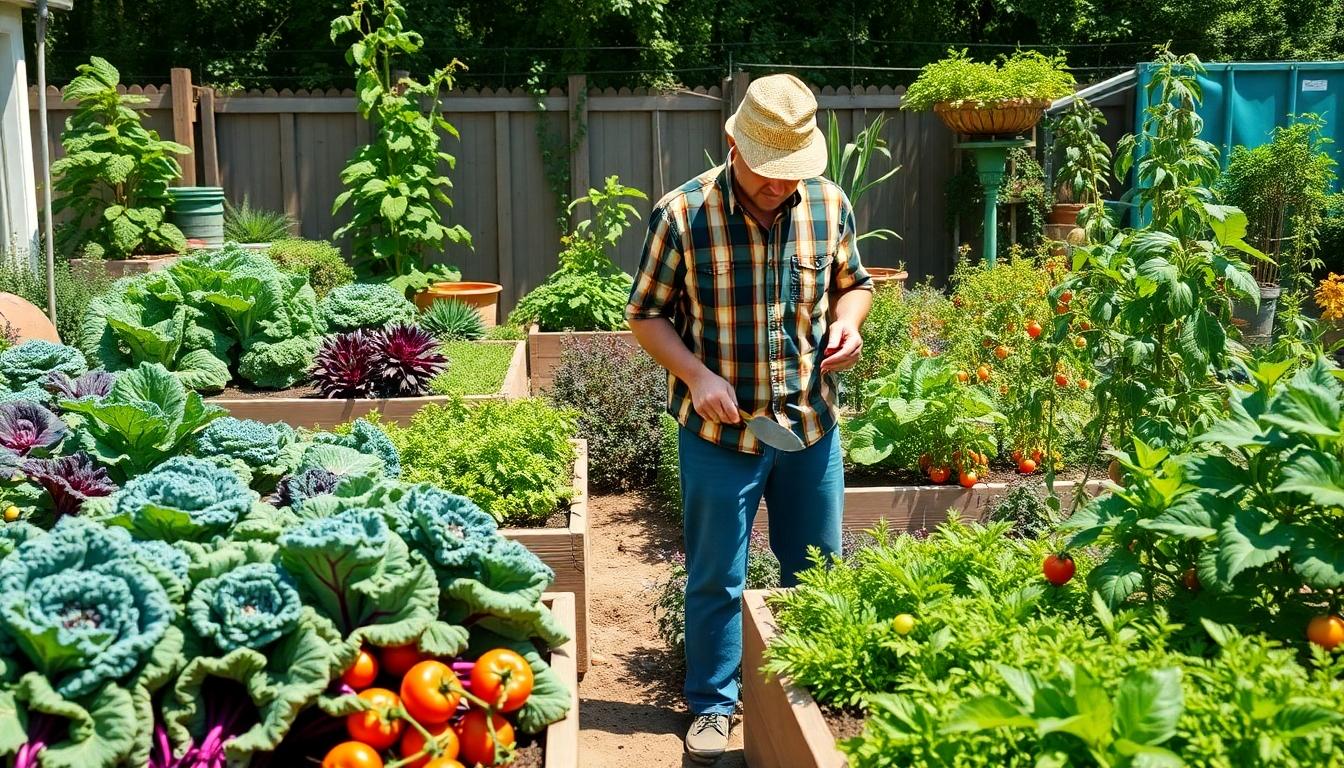
Creating a thriving superfood garden requires the right equipment and materials. We’ve compiled the essential tools that will set you up for success in growing nutrient-dense foods at home.
Basic Gardening Equipment
Every superfood gardener needs reliable hand tools including trowels, pruners, and cultivators for efficient planting and regular maintenance. Raised beds or containers offer excellent answers for small spaces while providing better drainage for your superfoods. Grow lights become necessary when your garden receives less than 6 hours of daily sunlight, ensuring your plants get adequate light exposure for optimal growth. Adding a layer of mulch around your plants helps retain soil moisture and effectively suppresses unwanted weeds, creating ideal growing conditions for your superfoods.
Soil Testing and Amendment Supplies
pH test kits serve as crucial tools for determining your soil’s acidity levels, with most superfoods thriving in a 6.0-7.0 pH range. Organic compost works wonders for enriching your soil with essential nutrients that power superfood growth. Well-draining soil mixes prevent waterlogging issues that can damage delicate root systems. Fish emulsion and organic fertilizers boost plant development, particularly for nutrient-hungry varieties like kale and beets, which benefit from applications every few weeks during the growing season.
Irrigation Systems for Optimal Growth
Drip irrigation systems deliver precise amounts of water directly to plant roots, maintaining consistent moisture without the risk of waterlogging. Soaker hoses provide an affordable alternative that ensures even soil hydration across your garden beds. Rainwater collection systems capture chemical-free water, creating an environmentally friendly irrigation source for your superfoods. Moisture meters take the guesswork out of watering by allowing you to check soil conditions before adding more water, preventing both over and under-watering situations.
For maximum growing success, place your superfood garden in locations receiving at least 6 hours of daily sunlight. Fans help manage humidity levels, keeping them in the ideal 50-70% range for most superfoods. Beginners should start with resilient options like kale, beets, or tomatoes, which require minimal care while thriving in various climate conditions.
Choosing the Right Superfood Plants for Your Climate
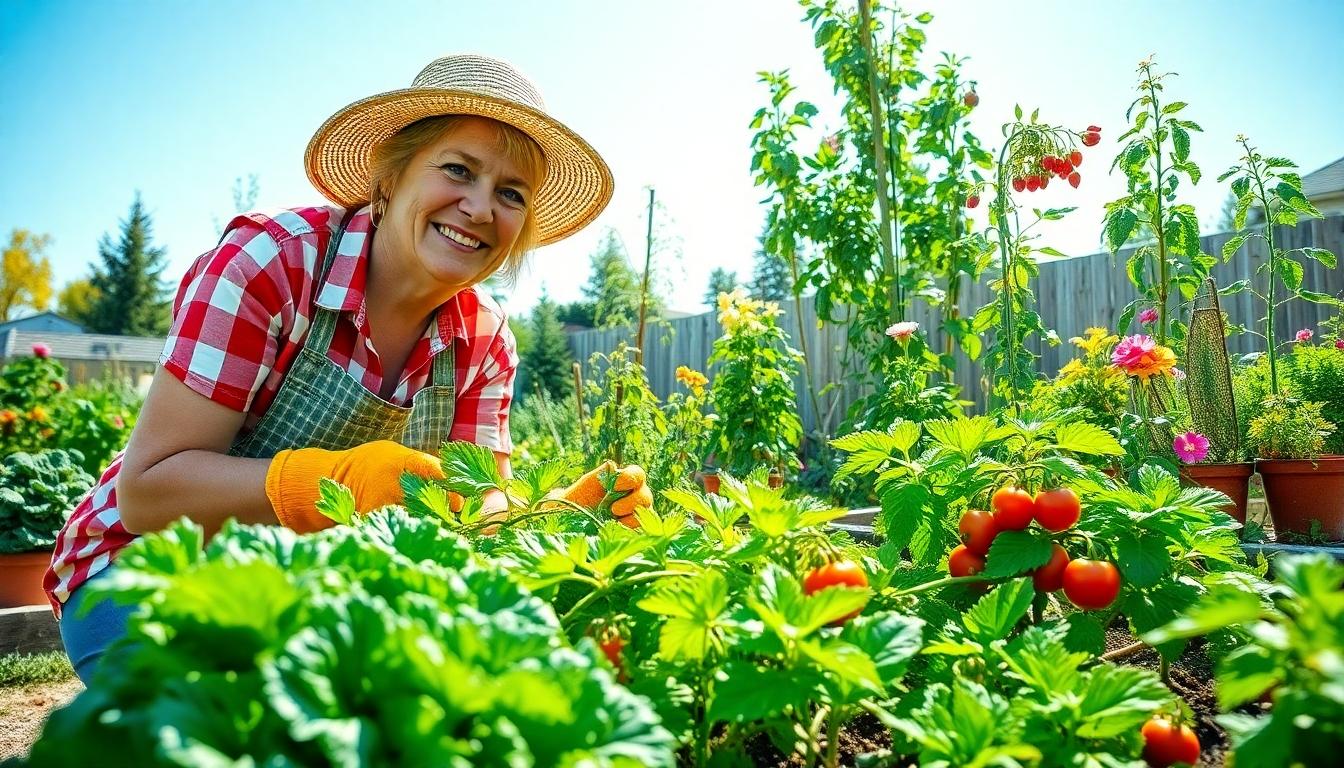
Matching your garden’s climate with appropriate superfood plants is essential for a successful harvest. Cold climates (USDA zones 3-6) require frost-tolerant varieties, while warm regions (zones 7-11) support heat-loving plants that thrive in higher temperatures. Understanding your exact growing conditions helps you select plants that will flourish in your backyard superfood garden.
Cold-Weather Superfood Varieties
Kale stands out as an exceptional cold-weather superfood, packed with vitamins A, C, and K. This resilient green thrives in cool temperatures and can withstand frost, making it perfect for northern gardens. Beets offer another excellent option for colder climates, delivering potassium and antioxidants while requiring minimal care—simply sow them directly into the soil after the threat of hard frost passes. Broccoli provides impressive amounts of fiber and vitamin C, performing best when planted either in early spring or late summer for a fall harvest. Jerusalem artichokes round out your cold-climate options with their prebiotic fiber content and remarkable cold resistance, growing successfully in zones 3-9 without special protection.
Warm-Weather Superfood Superstars
Tomatoes require full sun exposure and warm soil conditions to produce their lycopene-rich fruits. These garden favorites convert sunshine into nutritional powerhouses throughout the summer months. Berries like strawberries and blueberries thrive in warmer climates when provided with acidic soil and consistent moisture, rewarding gardeners with antioxidant-filled harvests. Goji berries flourish in well-drained soil with full sun access, developing drought tolerance once established, which makes them particularly valuable in warm, dry regions. Peppers contain impressive amounts of vitamin C and grow beautifully in both containers and garden beds that receive 6-8 hours of daily sunlight, making them versatile additions to warm-climate superfood gardens.
Year-Round Superfoods You Can Grow Anywhere
Microgreens deliver concentrated nutrition regardless of outdoor conditions, allowing harvest within just 1-3 weeks when grown indoors. These tiny powerhouses, including varieties like kale and radish, pack more nutrients per ounce than their full-grown counterparts. Herbs such as basil and cilantro adapt beautifully to pot cultivation with well-draining soil, starting easily in simple seedling trays before moving to permanent containers. Leafy greens including spinach and Swiss chard work perfectly in greenhouse environments or indoor hydroponic systems, providing nutritious harvests throughout all seasons. Lemons, particularly dwarf varieties like Meyer lemons, can transform into year-round producers when container-grown indoors with supplemental lighting, bringing citrus benefits to any climate zone.
Top 10 Easiest Superfoods to Grow in Your Backyard
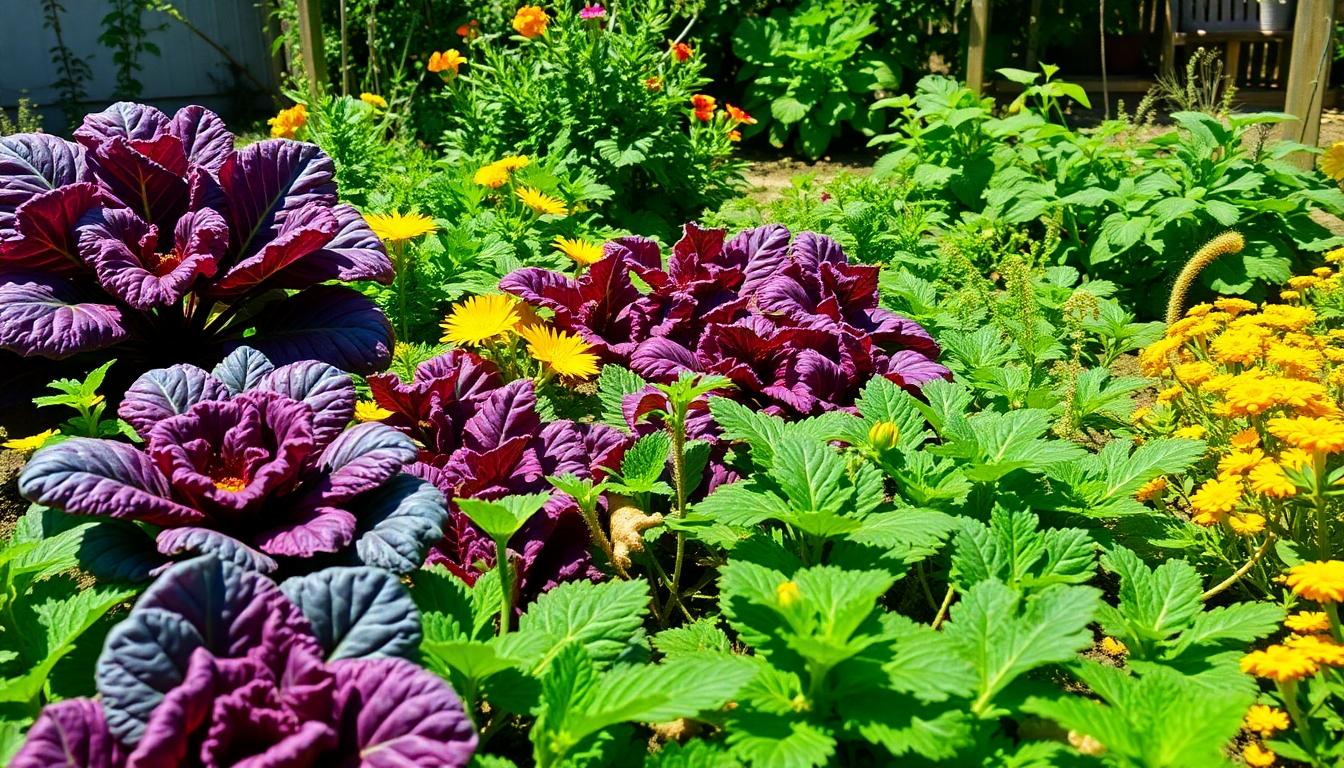
Ready to transform your garden into a nutritional powerhouse? We’ve compiled the top 10 superfoods that are surprisingly easy to grow and will provide maximum health benefits with minimal effort.
Leafy Greens: Kale, Spinach, and Swiss Chard
Kale thrives in both sunny and partially shaded areas, making it an incredibly versatile addition to any garden space. Its rich vitamin and antioxidant profile makes this hardy green worth the minimal effort required to grow it in well-drained soil. Spinach offers impressive iron content and grows quickly, preferring cooler weather and consistently moist soil for optimal production. Fast-growing and nutrient-dense, spinach can be harvested multiple times throughout a growing season with proper care. Swiss Chard stands out for its remarkable adaptability to various growing conditions, providing a continuous harvest of nutrient-packed leaves. This colorful leafy green remains productive in both cool and warm seasons, ensuring you’ll have access to fresh greens for extended periods.
Berries: Blueberries, Strawberries, and Raspberries
Blueberries require acidic soil but reward growers with antioxidant-rich fruits that support brain health and immunity. These versatile berries grow exceptionally well in containers, making them accessible even for gardeners with limited space. Strawberries rank among the easiest berries to cultivate, offering abundant vitamin C while adapting to various growing conditions. Their shallow root systems make them perfect for raised beds, hanging baskets, or dedicated strawberry pots. Raspberries establish themselves quickly and spread naturally, providing fiber-rich fruits with minimal maintenance requirements. Their perennial nature ensures years of harvests after the initial planting, making them a time-efficient addition to any backyard superfood garden.
Herbs: Turmeric, Ginger, and Holy Basil
Turmeric grows best in warm, humid environments where its anti-inflammatory rhizomes can develop fully underground. This golden superfood can be started from store-bought roots and thrives when given consistent moisture and protection from extreme temperatures. Ginger adapts remarkably well to container growing, making it accessible for gardeners with limited space. Its many health benefits include digestive support and immune-boosting properties, all from an easy-to-maintain plant that requires minimal attention. Holy Basil (also called Tulsi) grows quickly in well-drained soil and provides powerful antioxidant benefits to both body and mind. This aromatic herb can be harvested multiple times during a growing season, delivering continuous access to its stress-reducing and immunity-improving properties.
Other Superfoods
Sunchokes (Jerusalem artichokes) require virtually no maintenance once established and produce nutrient-rich tubers high in fiber. These native plants grow vigorously in various soil conditions, making them perfect for beginning gardeners looking to maximize nutrition with minimal effort. Their sunflower-like appearance adds ornamental value while their underground tubers provide healthful harvests year after year.
Step-by-Step Guide to Preparing Your Garden Space
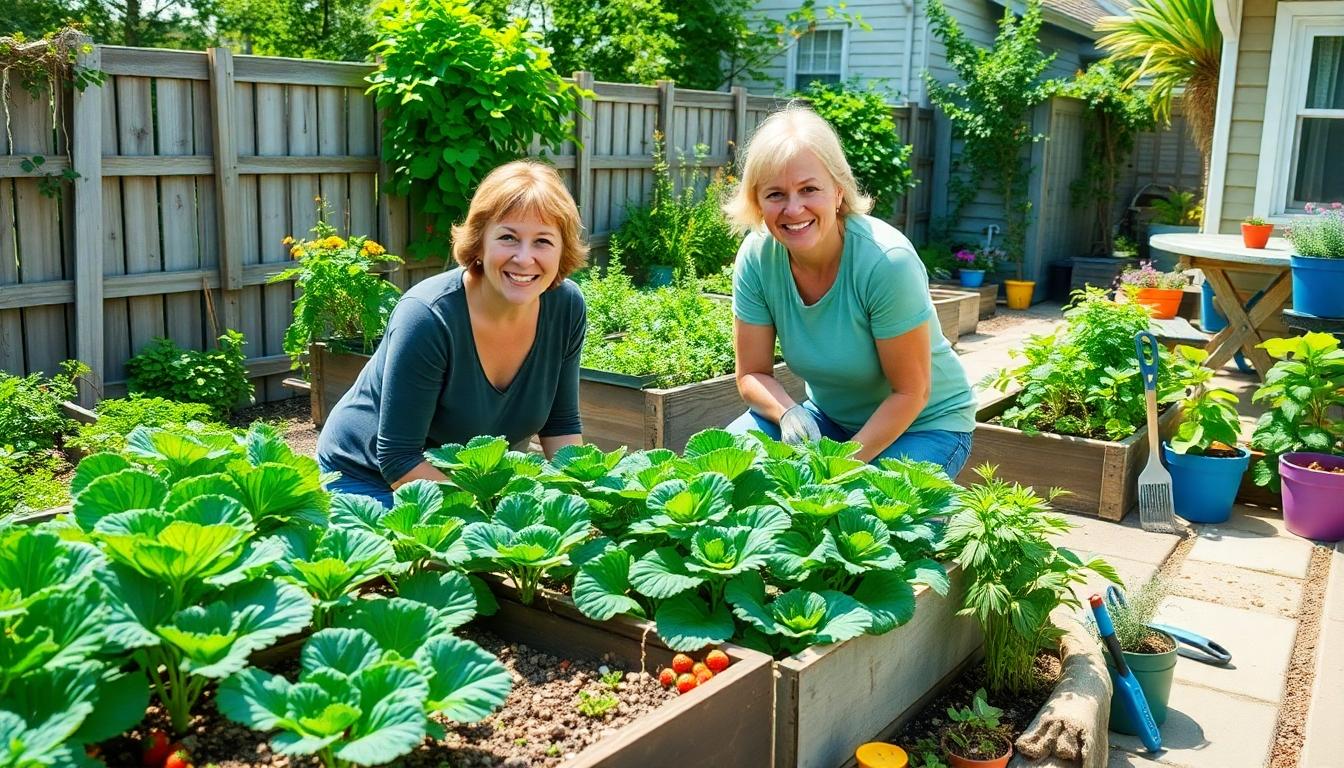
Proper preparation of your garden space is the foundation for growing nutrient-dense superfoods. We’ll walk you through the essential steps to create an optimal growing environment for your backyard superfoods.
Selecting the Perfect Location
Choosing the right spot for your superfood garden significantly impacts plant health and productivity. Look for an area that receives 6-8 hours of daily sunlight, as most superfoods including berries and leafy greens need abundant light to develop their nutritional qualities. Ensure your chosen location offers convenient access to water sources, saving you time and effort during dry periods. Protection from strong winds is equally important to prevent plant damage and excessive water loss. Testing your soil pH is a crucial step before planting – blueberries thrive in acidic soil with pH levels between 4.5 and 5.5, while most leafy greens prefer a more neutral pH range of 6.0 to 7.0 for optimal nutrient absorption.
Building Raised Beds vs. In-Ground Planting
Raised beds offer several advantages for growing superfoods, particularly for plants with exact soil requirements. These elevated growing spaces provide superior drainage, precise control over soil quality, and the ability to manage pH levels – especially critical for acid-loving berries. Fill your raised beds with nutrient-rich, well-draining soil to create an ideal growing medium for your superfoods. In-ground planting serves as a more cost-effective approach for cultivating larger areas, requiring less initial investment in materials and construction. Amend your existing soil thoroughly with quality compost before planting to improve fertility and structure. Your decision between these methods should consider your exact growing conditions, space constraints, and the particular needs of your chosen superfood plants.
Container Gardening Options for Limited Spaces
Container gardening makes superfood cultivation possible regardless of space limitations. Use pots of at least 5 gallons or fabric grow bags to provide adequate room for root development and moisture retention. Kale, strawberries, and dwarf blueberry varieties perform exceptionally well in containers, making them perfect choices for patios, balconies, or small yards. Always select containers with sufficient drainage holes to prevent waterlogged soil that can lead to root diseases. Fill your containers with high-quality organic potting mix specifically formulated for vegetables or berries. Container gardening allows for precise control of growing conditions and enables you to move plants as needed to optimize sun exposure throughout the season. With this approach, even urban dwellers with minimal space can enjoy the benefits of homegrown superfoods right outside their door.
Soil Preparation and Maintenance for Nutrient-Dense Crops
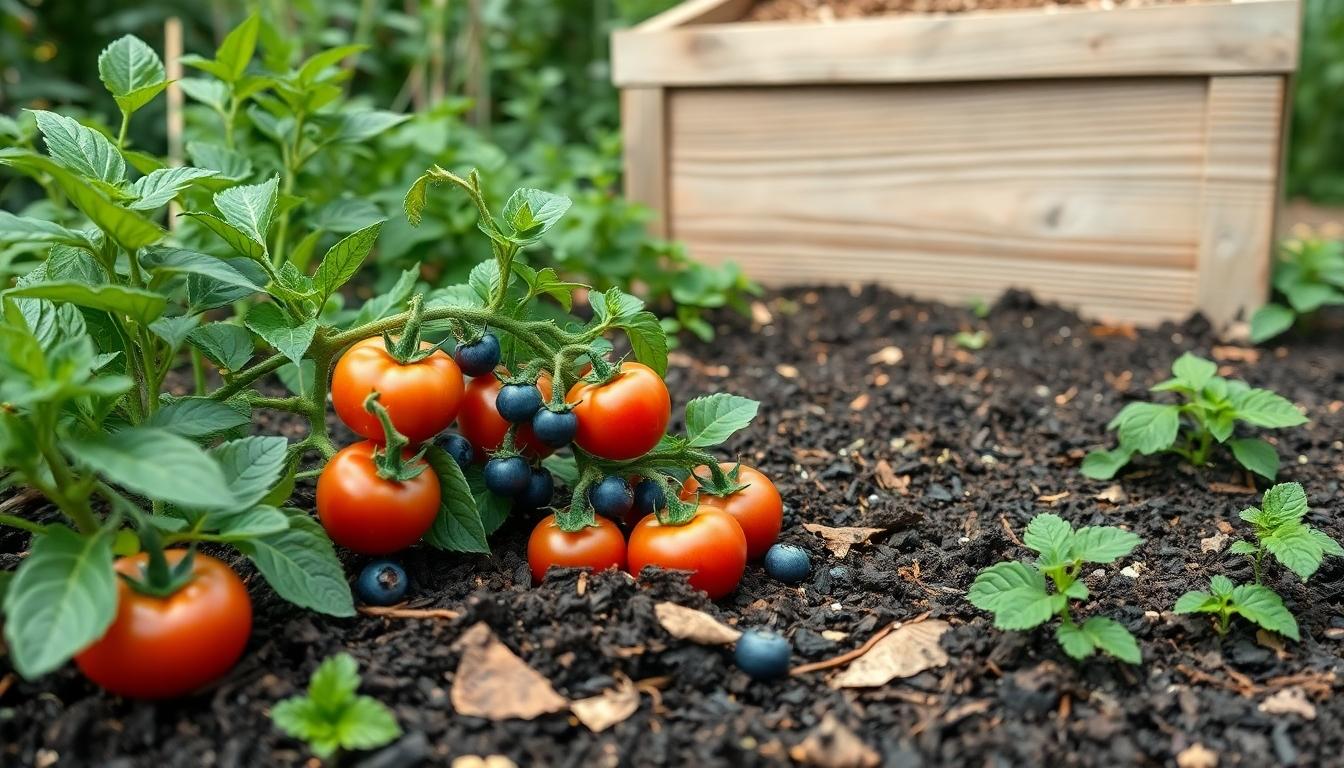
Understanding Soil Composition
Healthy soil forms the foundation for growing nutrient-dense superfoods in your backyard garden. Testing your soil’s pH and nutrient levels is essential as different superfoods have exact requirements—blueberries, for example, thrive in acidic soil with a pH between 4.5 and 5.5. Well-draining, loamy soils provide the ideal environment for most superfood crops, offering the perfect balance of water retention and aeration. Adding organic matter like compost or aged manure significantly improves soil structure, enhances fertility, and promotes beneficial microbial activity that supports plant health. We recommend conducting a soil test annually to monitor and adjust your garden’s growing conditions for optimal superfood production.
Organic Fertilization Methods
Natural fertilizers deliver superior results for growing nutritionally dense superfoods without harmful chemicals. Fish emulsion and seaweed extract work wonders as liquid fertilizers, providing readily available nitrogen along with essential micronutrients that boost plant immunity and nutrient content. Bone meal offers a slow-release source of phosphorus and calcium, particularly beneficial for fruit-bearing superfoods like tomatoes and berries. Applying organic mulch such as straw or grass clippings serves multiple purposes—it suppresses weeds, maintains soil moisture, and gradually decomposes to feed your plants. Regular applications of compost tea can revitalize your soil’s microbial population, creating a living network that enhances nutrient absorption and plant resilience.
Composting for Superfood Gardens
Creating your own compost transforms kitchen waste into garden gold for growing superior superfoods. Combine vegetable scraps, coffee grounds, and eggshells with yard waste like fallen leaves and grass clippings, maintaining a carbon-to-nitrogen ratio of approximately 3:1 for optimal decomposition. Turning your compost pile weekly introduces oxygen that accelerates the breakdown process and prevents unpleasant odors from developing. Finished compost dramatically improves soil structure, water retention, and nutrient availability while introducing beneficial microorganisms that form symbiotic relationships with your plants. We’ve found that gardens regularly amended with homemade compost produce superfoods with noticeably higher nutrient density and improved flavor compared to conventionally grown alternatives.
Maintenance Practices
Consistent care ensures your superfood garden continues producing nutrient-rich harvests throughout the growing season. Position sun-loving crops like tomatoes and berries where they’ll receive at least 6 hours of direct sunlight daily for maximum photosynthesis and nutrient development. Carry out drip irrigation to maintain even soil moisture while minimizing leaf wetness that can lead to fungal diseases. Adapt your garden to seasonal changes by growing cool-weather superfoods like kale and spinach during spring and fall, using shade cloth during intense summer heat to prevent premature bolting. Regular soil maintenance including light cultivation, proper watering, and seasonal amendments creates the perfect environment for producing backyard superfoods with exceptional nutritional quality.
Planting Techniques and Timing for Maximum Nutrient Content
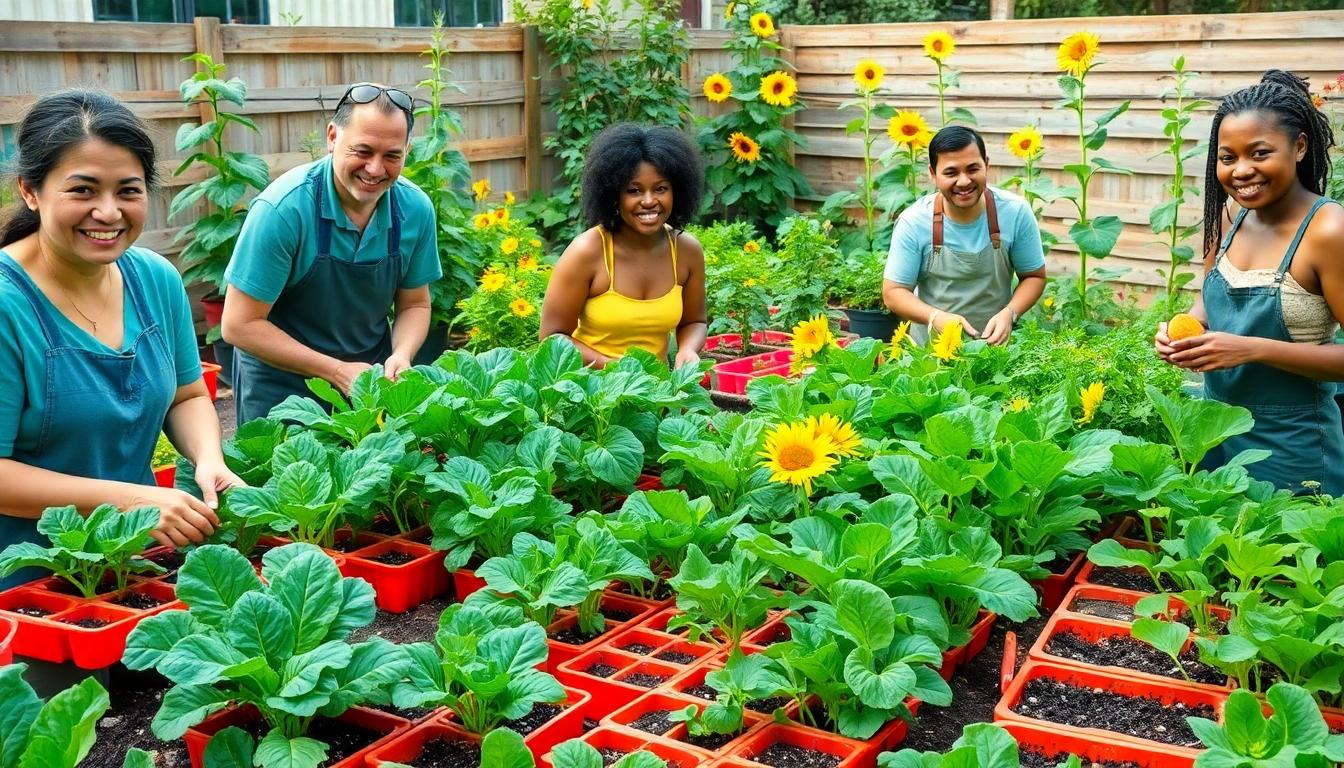
When growing superfoods, the methods and timing you choose significantly impact their nutritional value. Let’s explore the most effective techniques to maximize nutrient density in your backyard superfood garden.
Direct Seeding vs. Transplanting
Direct seeding works exceptionally well for quick-growing superfoods such as radishes, green beans, and sunflowers. Seeds should be sown at varying depths according to their size—larger sunflower seeds need approximately 3 inches of soil coverage, while smaller kale seeds require only about 0.5 inches. Plants that grow from directly sown seeds typically develop stronger, more extensive root systems, improving their ability to absorb nutrients from the soil.
Transplanting offers advantages for leafy superfoods like kale and Swiss chard, as well as herbs such as oregano. We recommend starting these seeds indoors in seed trays 6-8 weeks before your region’s last expected frost date. The controlled environment helps establish healthy seedlings that can be moved outdoors after a proper hardening-off period, giving your superfoods a head start on the growing season while maintaining their nutritional potential.
Seasonal Planting Calendar
Cool season superfoods thrive when temperatures range between 60-70°F, making spring and fall ideal for planting nutrient-dense options like kale, spinach, and chives. For best results, sow these seeds 4-6 weeks before the last frost in spring or as temperatures begin to cool in late summer for a fall harvest.
Warm season varieties including zucchini, green beans, and sunflowers require soil temperatures above 60°F to germinate properly and develop their full nutritional profile. Plant these superfoods after all danger of frost has passed in your growing zone to ensure optimal growth and nutrient development.
Year-round production becomes possible with temperature-controlled environments like greenhouses or indoor growing systems. Leafy greens and strawberries can produce continuously when maintained at daytime temperatures between 60-70°F, allowing for a steady supply of fresh, nutrient-rich superfoods regardless of outdoor conditions.
Companion Planting Strategies
Beans grow remarkably well alongside sunflowers in a mutually beneficial relationship. Tall sunflowers provide natural vertical support for climbing bean varieties, while beans fix nitrogen in the soil, improving the nutrient uptake capabilities of sunflowers. This partnership improves the nutritional quality of both plants.
Kale benefits significantly from being planted near chives, as the strong aroma of chives naturally deters common pests like aphids that can damage kale leaves. Protecting your kale plants from pest damage helps preserve their exceptional vitamin content and ensures healthier, more nutrient-dense harvests.
Strawberries paired with spinach create an effective growing combination for maximizing soil moisture retention. Spinach serves as living mulch around strawberry plants, helping maintain consistent soil moisture levels that support nutrient absorption and fruit development. This pairing not only conserves water but also enhances the nutritional quality of your strawberry harvest.
Natural Pest Control Methods for Organic Superfoods
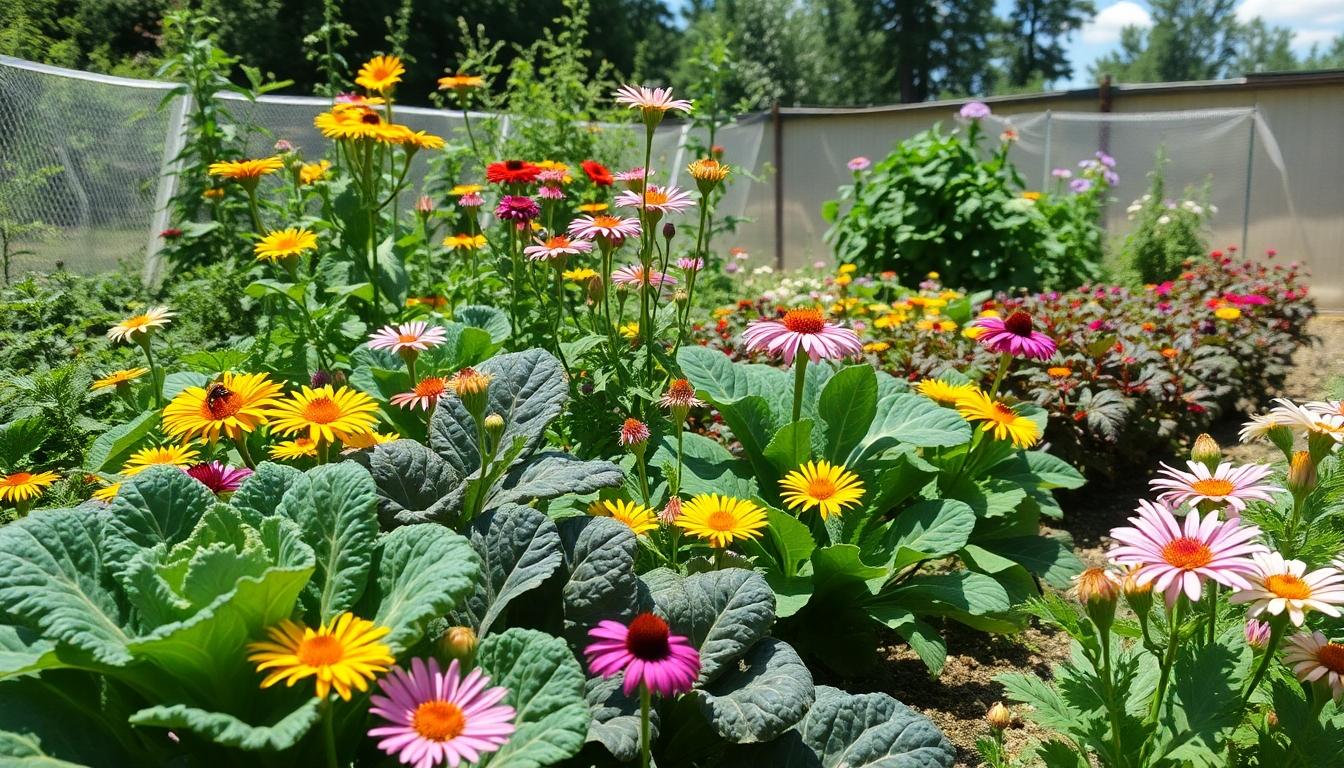
Growing organic superfoods requires effective pest management without resorting to harmful chemicals. Let’s explore natural answers that protect your nutrient-dense crops while maintaining ecological balance.
Beneficial Insects and How to Attract Them
Beneficial insects serve as nature’s pest control squad for your superfood garden. Ladybugs excel at controlling aphids and mites that can damage your nutrient-rich plants. We recommend planting dill, fennel, or yarrow to attract these spotted allies to your garden. Lacewings offer exceptional protection against soft-bodied pests and will visit gardens containing angelica, dill, or cosmos. Parasitic wasps target problematic caterpillars and beetles that might otherwise devastate your superfood crops. Sweet alyssum and cilantro provide perfect nectar sources to invite these helpful predators into your growing space. Creating a diverse garden network with these companion plants ensures continuous natural pest management throughout the growing season.
Homemade Organic Pest Deterrents
Creating your own organic pest sprays provides effective protection without introducing harmful chemicals to your superfood garden. Neem oil spray works wonders against aphids and mites when applied weekly – simply mix 1-2 teaspoons of neem oil with 1 quart of water and a few drops of dish soap. Garlic-chili spray repels chewing insects that target leafy greens and other superfoods. To make this potent deterrent, blend garlic, chili peppers, and water, then strain and dilute the mixture at a 1:10 ratio before application. Soap spray offers an immediate solution for soft-bodied pests like aphids by combining 1 tablespoon of mild liquid soap with 1 quart of water. These homemade answers work by smothering or deterring pests rather than introducing toxic substances to your edible plants.
Physical Barriers and Traps
Physical protection provides reliable defense against persistent pests targeting your superfood crops. Row covers made of lightweight fabric shield valuable leafy greens like kale and spinach from beetles and moths while still allowing sunlight and water to reach your plants. Copper tape creates an effective barrier against slugs and snails around containers or raised beds growing nutrient-dense foods. Sticky traps in strategic colors attract exact pest types – yellow traps effectively capture whiteflies, while blue traps work best for thrips that might damage your superfoods. Companion planting enhances these physical methods, with marigolds repelling harmful nematodes and basil deterring flies around tomato plants. Regular monitoring through early morning inspections allows for manual removal of larger pests like caterpillars before they cause important damage. Maintaining proper spacing and airflow between plants reduces fungal issues, creating an environment where your superfoods can thrive naturally.
Harvesting and Preserving Your Backyard Superfoods
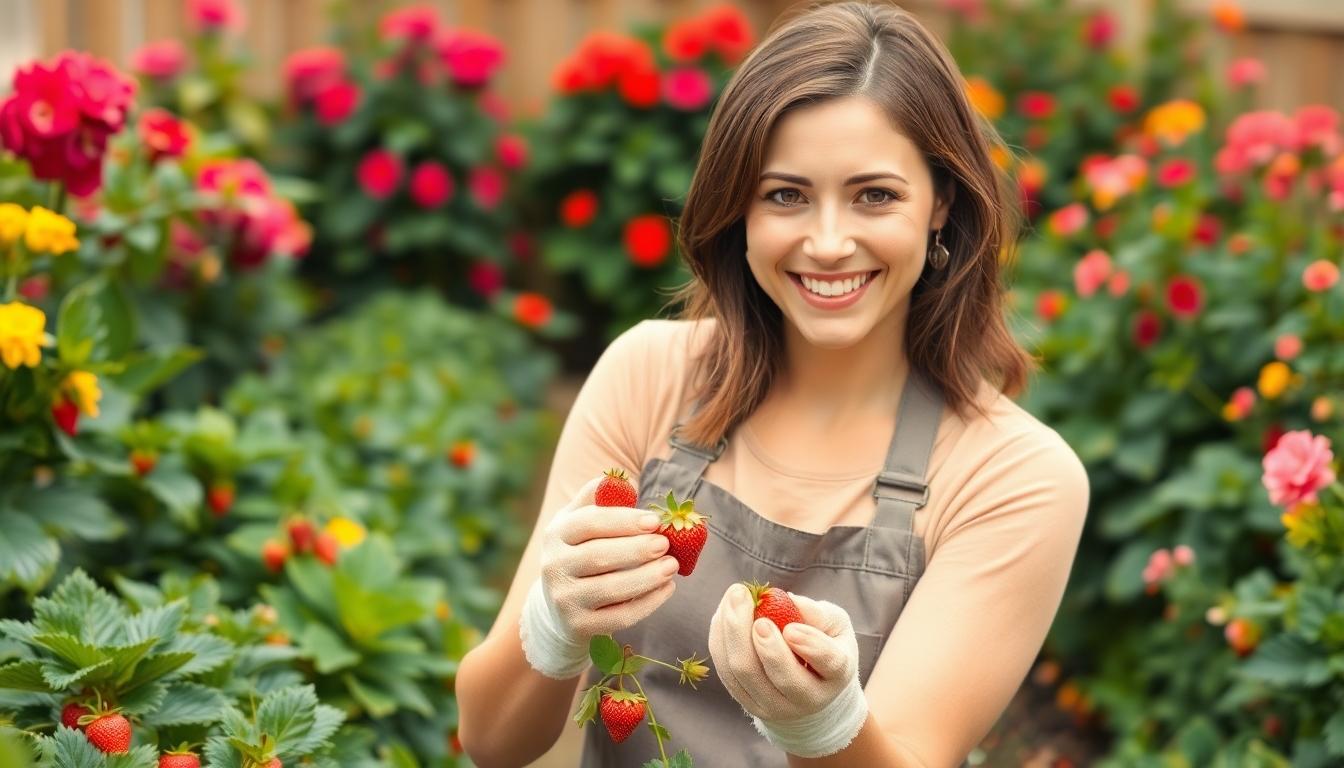
Growing your own superfoods is only half the journey. Knowing when and how to harvest and preserve them ensures you’ll maximize their nutritional benefits and enjoy them year-round.
Optimal Harvest Times for Maximum Nutrients
Timing your harvest correctly can significantly impact the nutritional value of your backyard superfoods. Leafy greens like kale and spinach should be harvested in the morning when their vitamin C levels reach their peak. Young leaves often contain the highest concentration of nutrients, making them ideal for superfood smoothies and salads.
Berries require careful attention to color and texture for optimal harvesting. Strawberries and other berries should be picked when they’ve developed their full color and feel slightly soft to the touch. Harvesting during cooler hours of the day helps preserve their valuable antioxidants that fight inflammation and support immune health.
Herbs such as oregano and chives deliver maximum flavor and nutritional benefits when harvested before they flower. This timing ensures the highest concentration of essential oils, which provide both medicinal properties and intense flavor profiles for your culinary creations.
Freezing and Dehydrating Methods
Freezing provides an excellent preservation method for many backyard superfoods, maintaining their nutritional integrity for months. Blanching vegetables like kale and green beans for 2-3 minutes before freezing helps preserve their vibrant color and nutrient content. This quick cooking followed by immediate cooling locks in vitamins that might otherwise degrade during storage.
Berry preservation works best with a flash-freezing technique. Spread your freshly harvested berries on a tray, freeze them individually, and then transfer to airtight containers. This method prevents them from clumping together, allowing you to grab just what you need for smoothies or desserts.
Dehydrating offers another powerful preservation option that concentrates nutrients while extending shelf life. Set your dehydrator between 130°F and 140°F for consistent, even drying of your superfoods. Sunflower seeds should be dried for 12-24 hours until they become brittle and snap easily when bent. Herbs require gentle handling—remove stems first, then dry until crumbly (typically 4-8 hours), and store in opaque containers to protect their valuable compounds from light degradation.
Fermenting Superfoods for Enhanced Benefits
Fermentation transforms already nutritious superfoods into probiotic powerhouses with enhanced bioavailability. This ancient preservation technique increases vitamin content, particularly B vitamins including B12, while making nutrients more accessible to your body.
Leafy superfoods like kale and chard can be transformed through simple fermentation. Shred the leaves finely, submerge them completely in a 2-3% salt brine solution, and allow them to ferment for 5-7 days at room temperature. The resulting fermented greens provide both probiotics and the original nutrients in a more digestible form.
Sunchokes (Jerusalem artichokes) develop incredible prebiotic properties when fermented. Slice these root vegetables thinly, place them in a salt brine with complementary flavors like garlic or dill, and wait for the beneficial bacteria to work their magic. Always use non-iodized salt for fermentation projects and ensure your jars are properly sterilized to prevent unwanted contamination that could spoil your superfood harvest.
Creating a Year-Round Superfood Production System

Establishing a continuous harvest of nutrient-dense foods requires strategic planning and implementation of various growing techniques. By combining seasonal planting strategies, protective structures, and indoor answers, you can enjoy fresh superfoods throughout all four seasons.
Succession Planting Techniques
Succession planting ensures a continuous supply of superfoods by staggering plantings throughout the growing season. Plant small batches of crops every 2-3 weeks to maintain steady harvests rather than experiencing feast-or-famine cycles. Cool season crops like kale, spinach, and beets thrive when planted in early spring or late summer for fall harvests. Warm season varieties such as microgreens, sprouts, and baby greens perform best during warmer months, providing quick harvests within weeks of planting. Rotating crops between different plant families helps maintain soil health and prevents disease buildup, which is particularly important for nutrient-demanding superfoods like blueberries and beets. This systematic approach to planting creates a perpetual harvest cycle that maximizes your garden’s productivity throughout the growing season.
Extending the Growing Season
Protective structures significantly lengthen your superfood growing calendar beyond traditional seasonal limitations. Greenhouses and cold frames create microclimates that shield plants from freezing temperatures, allowing for earlier spring plantings and later fall harvests of temperature-sensitive superfoods. Lightweight row covers provide frost protection that can extend harvests of kale and other greens several weeks into colder weather. Utilizing these season-extending tools enables you to grow cool-weather superfoods like kale during temperature drops that would otherwise damage exposed plants. Strategic placement of these structures in areas receiving maximum sunlight during winter months further optimizes growing conditions when daylight hours are limited. These methods effectively bridge the gap between summer abundance and winter scarcity in your superfood garden.
Indoor Growing Answers for Winter Months
Winter months don’t have to mean a pause in your superfood production with the right indoor growing setup. Container gardens offer versatile options for growing microgreens, sprouts, and baby greens indoors when outdoor conditions are inhospitable. Hydroponic systems provide efficient nutrient delivery for leafy greens without requiring soil, making them ideal for indoor winter growing. LED grow lights supply the necessary spectrum for photosynthesis when natural light is insufficient during shorter winter days. Windowsills facing south offer prime real estate for smaller superfood plants that require less space but still need natural light exposure. Kitchen countertop growing systems specifically designed for microgreens can produce nutritionally dense harvests in just 7-10 days, ensuring year-round access to fresh superfoods regardless of outdoor temperatures. These indoor methods complete your year-round superfood production system by filling the winter gap when outdoor growing becomes challenging.
Turning Your Harvest into Nutritional Powerhouses

After growing your backyard superfoods, it’s time to transform them into delicious and nutritious meals that maximize their health benefits.
Simple Superfood Recipes
Creating nutrient-dense meals with your homegrown superfoods doesn’t require culinary expertise. Kale smoothies offer an excellent way to incorporate leafy greens into your diet by simply blending fresh kale with strawberries and yogurt for a refreshing, vitamin-packed drink. Sunflower seed salads provide another quick option, combining your harvested greens with roasted sunflower seeds and a zesty lemon dressing for a meal rich in healthy oils and minerals. Fresh garden ingredients can transform ordinary dishes into nutritional powerhouses with minimal effort. Try tossing your homegrown berries into morning oatmeal or adding chopped leafy greens to omelets and pasta dishes for an instant nutrition boost.
Juicing and Smoothie Ideas
Juicing and blending represent perfect methods for concentrating the nutrients from your backyard superfoods. Berry Bliss juice combines homegrown blueberries, strawberries, and goji berries to create an antioxidant-rich drink that supports immune function and overall health. Green Goddess smoothies blend kale, spinach, and avocado into a nutrient-dense beverage packed with vitamins A, C, and K. Morning detox juices can feature your garden’s leafy greens with lemon and ginger for cleansing benefits. Seasonal smoothie bowls topped with fresh berries and sunflower seeds make nutritious breakfast options that showcase your garden’s bounty while providing sustained energy throughout the day.
Medicinal Preparations from Garden Superfoods
Many backyard superfoods possess powerful medicinal properties that you can harness through simple home preparations. Elderberry syrup, made from homegrown elderberries, serves as a natural cold remedy rich in immune-boosting compounds. Herbal teas brewed from garden-fresh oregano and chives provide soothing benefits for digestive health and respiratory support. Infused vinegars with chopped herbs concentrate the medicinal properties of your superfoods for use in dressings and tonics. Homemade tinctures from medicinal plants like echinacea can be prepared by steeping the fresh plant material in alcohol to extract beneficial compounds. These preparations allow you to transform your superfood garden into a natural medicine cabinet that supports wellness throughout the year.
Troubleshooting Common Problems in Your Superfood Garden
Even the most carefully tended superfood gardens encounter issues. Knowing how to identify and address common problems quickly can save your precious crops and maintain their nutritional value.
Identifying Nutrient Deficiencies
Nutrient deficiencies often manifest through visible symptoms in your superfood plants. Yellowing leaves across your kale or spinach typically indicate nitrogen deficiency, while stunted growth in berry bushes signals broader nutritional problems. Soil testing provides the most accurate diagnosis, revealing exactly which nutrients your garden lacks and in what quantities. Apply appropriate organic fertilizers based on test results—high-nitrogen mixes work particularly well for leafy greens like arugula and collards. Regular feeding schedules help prevent deficiencies from developing in nutrient-hungry superfoods such as broccoli and blueberries. Monitoring new growth after fertilization allows you to confirm whether your intervention has successfully addressed the deficiency.
Dealing with Disease and Mold
White powdery patches appearing on superfood leaves often indicate powdery mildew, while black spots suggest fungal issues affecting your plants. Early detection proves crucial for preventing the spread of disease throughout your garden, especially among clustered plants like strawberries or cabbage. Fungicides, particularly organic options like neem oil, can effectively treat many common superfood garden diseases. Remove severely infected plants immediately to protect neighboring crops from contamination. Proper air circulation between plants helps prevent mold development, making appropriate spacing essential when planting cruciferous vegetables. Watering at soil level rather than overhead reduces moisture on leaves where fungal spores thrive. Regular inspection of your superfood plants enables you to catch disease symptoms before they become severe problems.
Recovering from Weather Damage
Extreme weather events can leave superfood plants broken, bruised, or stressed. Physical damage, such as split stems on tomato plants or shredded kale leaves after hailstorms, requires prompt attention to prevent disease entry points. Provide support for damaged plants using stakes, trellises, or cages to prevent further breakage, especially for tall-growing superfoods. Trim off severely broken parts to redirect the plant’s energy toward healthy regrowth and fruit production. Water-stressed plants need gradual rehydration rather than sudden drenching to avoid shock. Cold-damaged berries and leafy greens often recover surprisingly well if protected from further temperature extremes after the event. Applying a light organic fertilizer helps stressed plants recover by providing readily available nutrients without forcing excessive new growth. Most resilient superfoods like collards and kale can bounce back from weather damage when given appropriate care and time to recover.
Building a Self-Sustaining Superfood Ecosystem
Growing backyard superfoods isn’t just about gardening—it’s a lifestyle choice that transforms how we nourish ourselves and connect with nature. By implementing the strategies we’ve shared you’ll create more than just a garden; you’ll establish a thriving network that provides nutrient-dense foods year-round.
Remember that your superfood garden will evolve with each season. Start small embrace the learning process and watch as your confidence grows alongside your plants. The journey from seed to table isn’t always perfect but the rewards—nutritional financial and environmental—are immense.
Your backyard superfood garden is waiting to become a cornerstone of your wellness routine and sustainable lifestyle. Take that first step today and join the growing community of home gardeners revolutionizing their health one homegrown superfood at a time.
Frequently Asked Questions
What are backyard superfoods?
Backyard superfoods are nutrient-dense plants that can be grown in home gardens, patio containers, or windowsills. These plants offer exceptional nutritional value compared to regular produce and include foods like berries, leafy greens, and herbs. They can be cultivated in various spaces, making them accessible regardless of your living situation.
Why should I grow superfoods at home instead of buying them?
Growing superfoods at home ensures fresher produce with higher nutrient content than store-bought alternatives. Home-grown superfoods offer significant financial savings, reduce your carbon footprint, and enhance food security. Additionally, you’ll have control over growing methods, avoiding pesticides and chemicals typically used in commercial farming.
What are the easiest superfoods to grow for beginners?
The easiest superfoods for beginners include kale, spinach, cherry tomatoes, blueberries, strawberries, and herbs like mint and basil. These plants are relatively resilient, require minimal maintenance, and can thrive in various conditions. Starting with these options will build your confidence before attempting more challenging varieties.
How much space do I need to grow superfoods?
You don’t need much space to grow superfoods. While a garden plot is ideal, many superfoods thrive in containers on patios, balconies, or even windowsills. Leafy greens and herbs can grow in small pots, while berries can be cultivated in larger containers. Vertical gardening techniques can also maximize limited spaces.
What basic tools do I need to start a superfood garden?
Essential tools include a trowel for planting, pruning shears, watering can or hose with adjustable nozzle, gloves, and containers if you’re not planting in-ground. You’ll also need quality soil, organic fertilizer, and seeds or seedlings. Most importantly, you need a location that receives at least 6 hours of sunlight daily.
When is the best time to plant different superfoods?
Planting times vary by superfood type. Cold-weather superfoods like kale and spinach should be planted in early spring or fall. Warm-weather superfoods such as tomatoes and berries thrive when planted after the last frost. Year-round options like microgreens and certain herbs can be grown indoors at any time. Always check specific planting guidelines for your climate zone.
How do I control pests without using chemicals?
Control pests organically by attracting beneficial insects like ladybugs and lacewings through companion planting. Use homemade deterrents such as neem oil spray or garlic-chili spray. Implement physical barriers like row covers and sticky traps to protect crops. Regular monitoring and proper plant spacing also help create an environment where superfoods can thrive naturally without chemical intervention.
What’s the best way to harvest superfoods to maximize nutrition?
Harvest at optimal times for maximum nutrition—leafy greens in the morning for peak vitamin C, berries when fully colored but slightly soft. Use sharp, clean tools to minimize damage. Handle produce gently and consume within hours of harvesting when possible. For leafy greens, harvest outer leaves first to allow plants to continue producing.
How can I preserve superfoods for year-round use?
Preserve superfoods by freezing berries and leafy greens immediately after harvest to maintain nutrients. Dehydrate herbs and fruits at low temperatures to retain beneficial compounds. Fermentation enhances nutritional value while creating probiotic-rich foods like sauerkraut. Store dried superfoods in airtight containers away from light and moisture for extended shelf life.
How do I create a year-round production system for superfoods?
Create year-round production through succession planting—staggering plantings throughout the growing season. Use protective structures like greenhouses and cold frames to extend growing seasons. Implement indoor growing systems such as container gardens or hydroponics for winter months. Plan your garden calendar to ensure continuous harvests across all seasons.
What are signs of nutrient deficiencies in superfood plants?
Look for yellowing leaves (nitrogen deficiency), purple-tinged leaves (phosphorus deficiency), or brown leaf edges (potassium deficiency). Stunted growth and poor fruiting can indicate multiple deficiencies. Conduct soil tests to identify specific issues and address them with appropriate organic amendments. Regular compost application can prevent many common deficiencies.
What are some simple ways to incorporate homegrown superfoods into meals?
Add leafy greens to smoothies, salads, and stir-fries. Use fresh herbs to enhance flavor in any dish. Create nutrient-dense juices by combining various superfoods. Make medicinal preparations like elderberry syrup or herbal teas. Even simple additions like sprinkling microgreens on sandwiches or adding berries to breakfast significantly boost your meal’s nutritional value.

